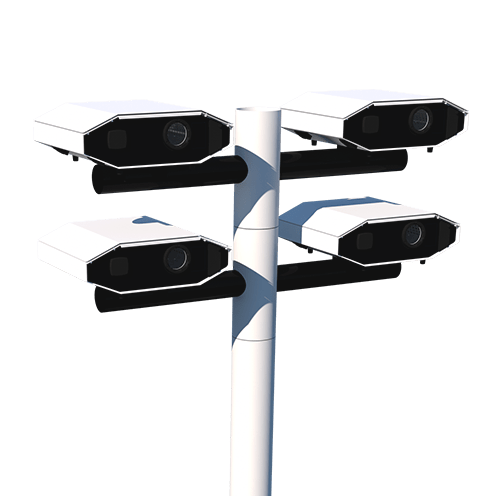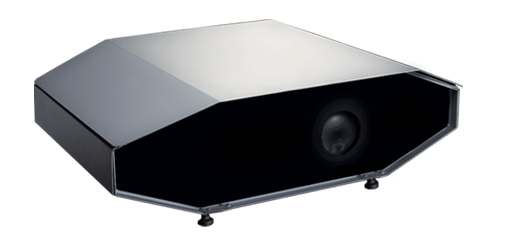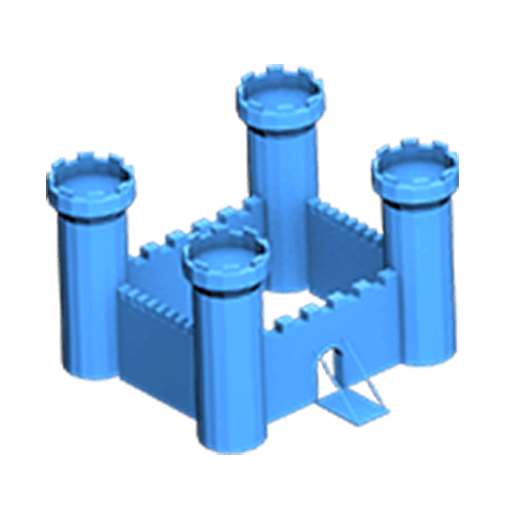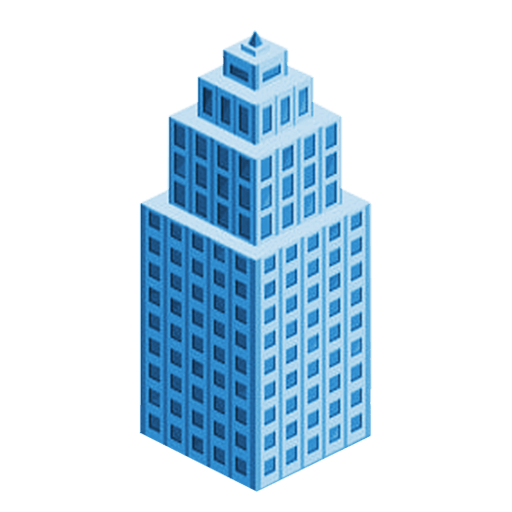LUMITRIX delivers the most advanced projection systems in the world. However, technology is something behind the scene. The audience doesn’t see it. What matters is the content. Only by content, you bring the desired experience. In this article, we will have a look at three ways how you can create innovative content by using projected light.
First things first – let’s have a short look back to the past but sadly often present of standard projection mapping projects.
Standard way
Projection mapping (or video mapping) as we know it today is projecting deformed pictures or videos on any 3D object. We use the shape of the object to map content around it. In other words, we customise the content to fit the geometry of the illuminated object.
The most usual projects of today use powerful projectors to illuminate huge buildings. Of course, a projector is not the only thing you need.

If we take a standard workflow of those large-scale video mapping projects, it looks something like this:
- You build a tower which gives shelter to those very powerful, big and expensive projectors housed inside.
- You find a DSLR camera with similar optics as your projector’s lens and take some pictures of the building which you’re going to map.
- Out of those pictures, you create a scan of the building that you use as a background for your animation. If you’re lucky, you get a 3D model of the building.
- You design the content – usually on-site – in one of the specialised software that you first need to learn. Some of the most used VJ software is MadMapper or Vioso.
- You press the play button at the right time, hope nothing goes wrong, and you eventually please your audience.
- You pack all that expensive stuff and go mapping another building somewhere else. The only memory of your great work will be a YouTube video you upload to your channel.
A bit sad. Isn’t it? So much effort, so much great work and all that for a few breath-taking moments for only a few lucky people that were on the right place at the right time.
LUMITRIX way
LUMITRIX started writing its history when its founder, Lukas Brus, cooperated on such standard mapping show in his home town. He immediately fell in love with projection mapping and saw significant potential in using projected light to illuminate buildings and other objects. However, he found the standard workflow (mentioned above) awkward. During their show, it started to snow, so they had to cover the expensive projectors and also in the middle of the show the battery of the laptop which was playing the content suddenly stopped working because of the cold weather.
As this show was spoiled, Lukas decided to purchase professional equipment for video mapping. The problem was, there wasn’t any! So eventually, he decided to build one.
After two years of prototyping, LUMITRIX has announced its first product called Typhoon (today known as the T2). The automatic outdoor projection system for video mapping and light design.
What this product was about is easily wrapped-up on this picture:

And this one:

1) Advanced custom-designed content
So how does the standard mapping project look like if you use LUMITRIX technology? How does LUMITRIX simplify the process of content creation? A lot!
- Take the T2 out, fix it on a wall or a city light post (using state of the art fixtures) opposite the object you want to map. Plug the device to the electricity, connect the device to the internet via cable or built-in SIM card slot.
- Scan the building/object via the integrated night-vision camera.
- Use this pixel-by-pixel precise scan to create your artwork (use any software you already know – e.g. Adobe After Effects) and send your content back to the unit via the internet.
- Schedule when your content should be played, and it will start automatically right at that time.
As the T2 unit is IP protected and it can stay outside the whole year, you can play this content repeatedly. Or create another content and choose which days to play which etc.
Check an example of a custom-designed content for national heritage (Pernštejn) or way more straightforward but still custom-designed content used in light design (Feldkirch).
By this, we opened the world of projection mapping to any motion picture designer or artist in the world. No more hard times learning the new software, no more on-site works, no more security around the tower housing projectors. Just a simple-to-use stand-alone unit playing your content wherever and whenever you want.

Nevertheless, there was one more challenge to overcome. You still needed to be a motion picture designer – you needed to know how to create content from scratch. However, our idea was to open the world of projection mapping to everyone. That is where Lumiverse had to come for help.
2) Lumiverse for easy mapping and light design
In 2017 we launched the first version of the new Lumiverse App that simplified the process of “projecting anything on anything” even further. We thought about light designers and other artists that have a sense for composition but cannot design content from scratch. Our task was to develop a simple drag & drop mapping editor that can be used by anyone.
Lumiverse is designed as a web app so that you can open it through any device you want (not only your laptop but any smartphone or a tablet). Technically, it’s a cloud-based solution when on one side you have the interface on your device, and on the other side, there is some LUMITRIX product (LUMIBOX or T2) which listens to your instructions.
Each product comes with a built-in and ever enlarging library of content from which you can compose beautiful scenes. Of course, you can upload your content or anything that you downloaded from the internet.
The best is to try it yourself but for now, check Lukas introducing the Lumiverse 2:
As our vision is that projections will eventually become a part of our everyday lives and they will play an essential role in the ‘ubiquitous computing’ concept we haven’t designed Lumiverse to play pictures and videos only. We made it run HTML5 apps as well.
By that, Lumiverse becomes a sort of operating systems for projectors. Difficult to imagine? Let’s take a laptop. It has different parts one of which is a screen – in our case, this is a projector. All the rest – hardware bearing computing power, keyboard, trackpad, on/off button, network card for connection to the internet – this is a LUMITRIX product (media-server itself – LUMIBOX – or media server hidden inside the T2). And software – the part through which you actually use the machine (Windows, OS X) – that’s, in our case, LUMIVERSE. The operating system for projectors. A simple user interface that makes the job done.
Thanks to this, you can now play projected Tetris on a 20m high wall while waiting for your tram or choose the colour of your bag in a boutique. That’s, of course, just the beginning.
Remember when Steve Jobs introduced the first iPhone back in 2007? iOS – the operating system for iPhones was quite basic from today’s point of view. You had some basic apps like notes, calculator or email. Just 10 years later, thousands of new apps are available in AppStore every day!
In LUMITRIX, we still strive to deliver the best projection systems in the world. Now we also encourage people from all around the world to join our platform and seek where projections might make sense. Interactive OOH advertising? Ultimate light design tool? Light brush? Industry 4.0? Surprising digital signage? Permanent mapping on national heritage buildings?
Actually anything. And all with the same device. The platform is here. The choice is yours. All you need is light.
3) Interactive HTML5 apps in Lumiverse
As our vision is that projections will eventually become a part of our everyday lives and they will play an essential role in the ‘ubiquitous computing’ concept we haven’t designed Lumiverse to play pictures and videos only. We made it run HTML5 apps as well.
By that, Lumiverse becomes a sort of operating systems for projectors. Difficult to imagine? Let’s take a laptop. It has different parts, one of which is a screen – in our case, this is a projector. All the rest – hardware bearing computing power, keyboard, trackpad, on/off button, network card for connection to the internet – this is a LUMITRIX product (media-server itself – LUMIBOX – or media server hidden inside the T2). And software – the part through which you use the machine (Windows, OS X) – that’s, in our case, Lumiverse. The operating system for projectors. A simple user interface that makes the job done.
Thanks to this, you can now play projected Tetris on a 20m high wall while waiting for your tram or choose the colour of your bag in a boutique. That’s, of course, just the beginning.
Remember when Steve Jobs introduced the first iPhone back in 2007? iOS – the operating system for iPhones (iOS) was pretty empty from today’s point of view. You had some essential apps like notes, calculator or email. Just ten years later, thousands of new apps are available in AppStore every day!
In LUMITRIX, we still strive to deliver the best projection systems in the world. Now we also encourage people from all around the world to join our platform and seek where projections might make sense. Interactive OOH advertising? Ultimate light design tool? Light brush? Industry 4.0? Surprising digital signage? Permanent mapping on national heritage buildings?
Actually – anything – and all with the same device. The platform is here. The choice is yours. And all you need is light.














